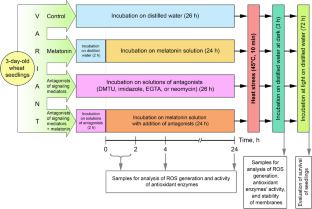Protoplasma ( IF 2.9 ) Pub Date : 2024-04-16 , DOI: 10.1007/s00709-024-01952-z Yuriy E. Kolupaev , Dmytro A. Taraban , Yuriy V. Karpets , Alexander I. Kokorev , Tetiana O. Yastreb , Yaroslav B. Blume , Alla I. Yemets

|
The stress-protective effect of melatonin (N-acetyl-5-methoxytryptamine) on plant cells is mediated by key signaling mediators, in particular calcium ions and reactive oxygen species (ROS). However, the links between changes in calcium and redox homeostasis and the formation of adaptive responses of cultivated cereals (including wheat) to the action of high temperatures have not yet been studied. In the present study, we investigated the possible involvement of ROS and calcium ions as signaling mediators in developing heat resistance in wheat (Triticum aestivum L.) seedlings and activating their antioxidant system. Treatment of 3-day-old etiolated seedlings with melatonin solutions at concentrations 0.01–10 µM increased their survival after exposure to 45 °C for 10 min. The most significant stress-protective effect was exerted by melatonin treatment at 1 µM concentration. Under the influence of melatonin, a transient enhancement of superoxide anion radical (O2•–) generation and an increase in hydrogen peroxide content were observed in roots, with a maximum at 1 h. Four hours after treatment with melatonin, the activity of catalase and guaiacol peroxidase increased in roots, while the activity of superoxide dismutase did not change significantly. After exposure to 45 °C, the activity of catalase and guaiacol peroxidase was higher in the roots of melatonin-treated wheat seedlings, and the indices of ROS generation, content of the lipid peroxidation product malonic dialdehyde, and cell membrane damage were lower than in control seedlings. Melatonin-induced changes in root ROS generation and antioxidant enzyme activities were eliminated by pretreatment with the hydrogen peroxide scavenger dimethylthiourea (DMTU), NADPH oxidase inhibitor imidazole, and calcium antagonists (the extracellular calcium chelator EGTA and phospholipase C inhibitor neomycin). Treatment with DMTU, imidazole, EGTA, and neomycin also abolished the melatonin-induced increase in survival of wheat seedlings after heat stress. The role of calcium ions and ROS, generated with the participation of NADPH oxidase, as signaling mediators in the melatonin-induced antioxidant system and heat stress resistance of wheat seedlings have been demonstrated.
中文翻译:

褪黑素作用下ROS和钙离子参与小麦幼苗耐热性发育和抗氧化系统诱导
褪黑激素(N-乙酰基-5-甲氧基色胺)对植物细胞的应激保护作用是由关键信号传导介质介导的,特别是钙离子和活性氧 (ROS)。然而,钙和氧化还原稳态的变化与栽培谷物(包括小麦)对高温作用的适应性反应的形成之间的联系尚未研究。在本研究中,我们研究了活性氧和钙离子作为信号介体在小麦( Triticum aestivum L.)幼苗耐热性发展和激活其抗氧化系统中的可能参与。用浓度为 0.01-10 µM 的褪黑激素溶液处理 3 天黄化的幼苗,在 45 °C 下暴露 10 分钟后,可提高幼苗的存活率。 1 µM 浓度的褪黑激素处理发挥了最显着的压力保护作用。在褪黑激素的影响下,根部观察到超氧阴离子自由基(O 2 •–)产生短暂增强,过氧化氢含量增加,在1小时时达到最大值。褪黑素处理4 h后,根部过氧化氢酶和愈创木酚过氧化物酶活性升高,而超氧化物歧化酶活性没有明显变化。 45℃暴露后,褪黑素处理的小麦幼苗根部过氧化氢酶和愈创木酚过氧化物酶活性较高,ROS生成、脂质过氧化产物丙二醛含量、细胞膜损伤等指标均低于处理后的小麦幼苗。控制幼苗。通过使用过氧化氢清除剂二甲基硫脲 (DMTU)、NADPH 氧化酶抑制剂咪唑和钙拮抗剂(细胞外钙螯合剂 EGTA 和磷脂酶 C 抑制剂新霉素)进行预处理,可以消除褪黑素诱导的根部 ROS 生成和抗氧化酶活性的变化。用 DMTU、咪唑、EGTA 和新霉素处理也消除了褪黑素诱导的热应激后小麦幼苗存活率的增加。 NADPH 氧化酶参与产生的钙离子和 ROS 作为褪黑激素诱导的抗氧化系统和小麦幼苗抗热应激中信号传导介质的作用已得到证实。



























 京公网安备 11010802027423号
京公网安备 11010802027423号